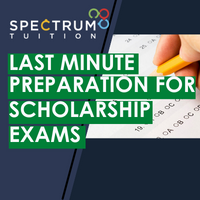We’re almost at the end of January already. You know what this means? It means that in just over a month, thousands of year 6 students across the start will be sitting their exams in hope of gaining scholarships to the private school of their choice. For these students, the chance of getting a scholarship is often a once in a lifetime opportunity to get a high-quality education at an affordable price.
For this reason, many students have been preparing for this moment for the past year. Others are going in having never seen a practice test in their lives. If your child fits into either one of these categories, whether they have been attending scholarship classes for a year or whether they are at the first stage of their exam preparation, there are some very specific things that they can do in the next month to maximise their chances of success!
1. Get Informed
Before you start preparing your child for a Scholarship exam, it’s important to have all the possible information online at your disposal. There is a lot of information out there about the specific areas covered by each of the exams. It is important that you look at this information carefully to find out exactly what your child has to prepare for. If your child seems to really be struggling with some of the work, looking for a tutor to help them consolidate their knowledge might be a good move in the run-up to exam season.
Check out our website for a useful summary of each of the scholarship exams. It is also a good idea to check out the website of the exam that your child will be sitting.
2. Practice Writing Under Time Limits
One of the most difficult parts on the scholarship exam is the writing component. Students will be required to produce a creative narrative and a well-structured argumentative essay under an incredibly strict time limit. As a guide, students will only have around 25 minutes to plan and write each of their writing tasks. For students who are unfamiliar with writing under a time limit, this can be a nearly impossible task. But, as always, practice makes perfect.
Start by getting your child to write a practice essay in 40 minutes. Once they are able to do this, shorten the time limit to 35 minutes, then 30, and then eventually 25. This can be a struggle for many students as they are used to writing extended pieces without a time limit. However, no matter the time limit, practice is practice, and practice makes perfect. For some, it may be worth practising writing papers without a time limit first, in order to consolidate the content before worrying about time. Once this has been done, you can then move on to writing similarly excellent essays under timed conditions. As a guide, here is a suggestion for how long your child should spend on each section of a 25 minute essay.
Planning – 2 minute
Introduction – 3 minutes
Body Paragraphs – 16 minutes
Conclusion – 3 minutes
Editing – 1 minutes
3. Focus On Essay Structure
This relates to the point above, but it deserves emphasising. If your child is going to be successful in the argumentative writing component of their exam, then they need to have a clear sense on how to structure an essay, and what to put in each section. This will make their essay clearer to read, and also help your child to structure their ideas in the strict time limit. Every essay should include the following sections.
1. Introduction.
-Usually around 5 sentences.
-Introduces the topic.
-Clearly states the contention, or main opinion of the piece.
-Summarises the 2-3 main arguments that support the contention.
-Concludes by linking these argument to the contention.
2. Body paragraphs.
-2-3 paragraphs, one for each argument. Each paragraph should focus on just one argument.
-Should start with a topic sentence that links the contention to the argument. For example “Smoking should be illegal (contention) because it is bad for your health (argument).”
-Gives evidence and reasons why the argument is correct.
3. Conclusion.
-Summarises all the arguments given in the body paragraphs.
-Ends by restating the contention.
For more information on structuring and writing creative pieces, check out this blog post.
4. Get On Top Of Mathematics Skills
When it comes to maths, the scholarship exams can get a little rough. They aim to single out the best of the best, so they often cover work that may be over complicated or even unfamiliar to most grade 6 students. It is important that your child is on top of their basic mathematics skills. They should be able to solve times tables quickly, add and multiply fractions, deal with percentages, follow the orders of operation (BODMAS) and interpret patterns and graphs. The exam also relies of some basic algebra, which is often not taught until high school, so it may be a good idea to introduce your child to the basic concept of x’s and y’s before they sit the test.
How Can We Help?
This may sound very daunting. It’s hard to face such a task alone. Fortunately, Spectrum Tuition offer a range of options for students who want some last minute help preparing for their exams. Though it’s too late to enrol for our Scholarship Preparation course for this year’s exam, there are still a number of options available.
Exam packs
We offer a range of custom-made practice Scholarship exam packs. These practice exams are based on our years of experience preparing students for the exam, and cover all the areas that the Scholarship exam covers.
Our exam packs can be used as general study tools, but they can also be tailored to focus on specific areas of weakness. In addition, we offer an extra essay feedback service, in order to give your child a chance to dramatically improve their argumentative and creative writing skills.
Check out our digital bookstore for more information.
Private tutoring
If your child still has a specific area of difficulty and needs a bit more personalised attention, then private tutoring is a great option. Many of our university educated private tutors have sat similar exams themselves and are able to give specific feedback and instruction where your child needs it the most. For more information on private tutoring, check out our website.


